Understand EVMOS in one article, and what it means for cross-chain communication and modularity
Author: RainandCoffee, Contributor to "the weekly depths"
Compiled by: DeFi Path
If you are still unclear, let me tell you that the future belongs to multi-chain; the days when most people were limited to a single blockchain are long gone. Nowadays, most people are using multiple blockchains to maximize yields, search for new gem codes, and so on.
So, let’s dive into the world of EVMOS and what it means for interoperability, cross-chain communication, and modularity.
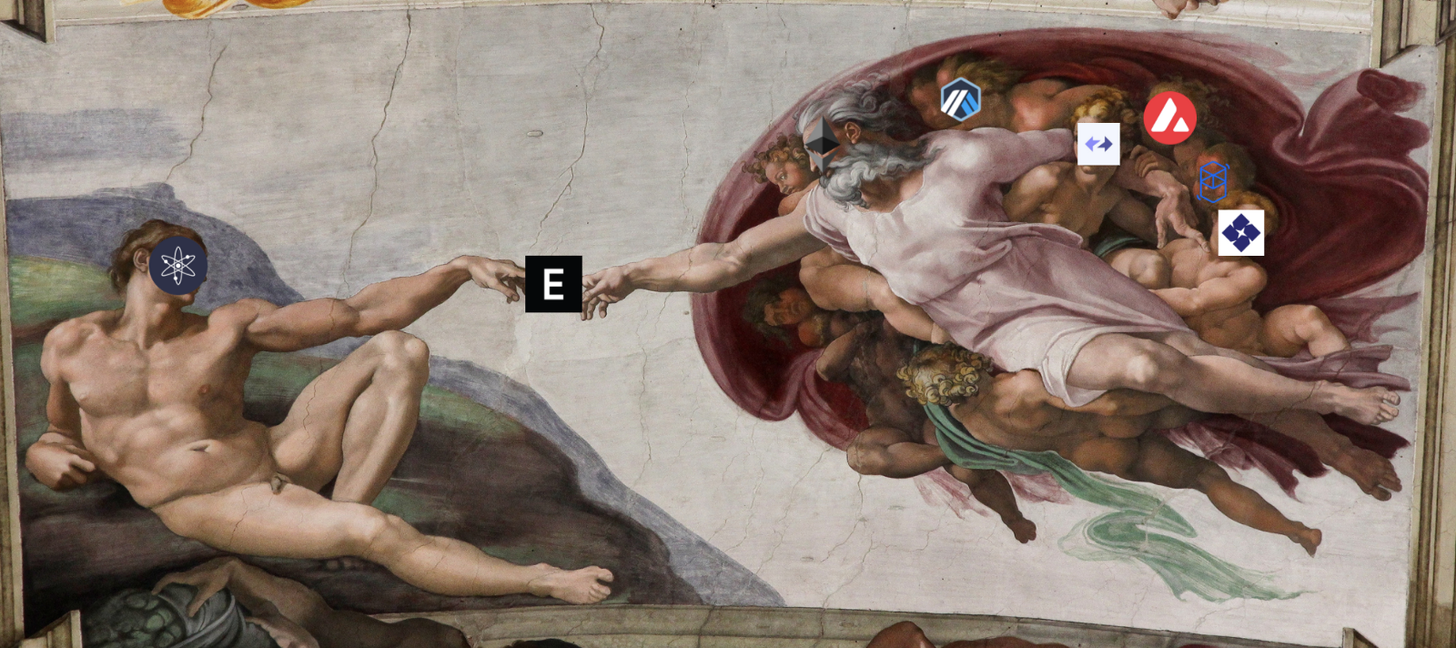

Currently, Evmos has not issued a token, but its highly anticipated airdrop and mainnet launch are expected to take place on February 28. So, sit back, grab a cup of coffee, and let’s delve into Evmos to get prepared.
Introduction
Let’s start by determining what EVMOS stands for — it’s quite simple, EVMOS combines EVM and CosmOS.
This name clearly indicates the mission of EVMOS, which will serve as the connection point between EVM and the Cosmos ecosystem. Before we delve into the technical aspects of EVMOS, let’s first take a look at why it is so groundbreaking.
In short, Evmos aims to integrate EVM-compatible chains (not just Ethereum) into the Cosmos ecosystem. This means that EVM blockchains like Fantom, Avalanche, and Harmony can consolidate assets into the Cosmos IBC ecosystem through Evmos. In other words, decentralized applications, tokens, and NFTs based on EVM can all connect to the Cosmos ecosystem.
However, what many may not know is that the idea of EVMOS appeared as Ethermint back in 2016. The goal of Ethermint was to bring the Tendermint consensus protocol to Ethereum. But this goal has already been achieved through rollups like Arbitrium, so the original Ethermint chain no longer has a value proposition.
Thus, the Tharsis team (responsible for developing Evmos) decided to commit to their new vision — to build a highly secure, fast-finality, EVM-based blockchain on Cosmos that can provide interoperability and greater composability for smart contracts between IBC and Ethereum.
Before we proceed, let’s quickly understand what EVM and Finality represent:
EVM is Ethereum's virtual machine, which enables developers to build and create decentralized applications that work on Ethereum and similar chains.
Finality refers to the guarantee that once a transaction is completed, it cannot be changed, revoked, or canceled. Essentially, finality indicates the time required for the network to confirm a transaction, thereby determining the chain's finality rate.


Fast/Instant Finality of Tendermint (+2/3 validators)
It’s no surprise that fast finality quickly gained a lot of traction in the Ethereum community, with even Vitalik writing about the need for a Tendermint-like consensus model for Ethereum.
EVMOS
Now that we have established the background and basic concepts of Evmos, it’s time to delve deeper into the protocol, what it aims to achieve, and more.
Evmos will be a sovereign "application-specific chain" that will interoperate with Ethereum, EVM-compatible environments, and other BFT chains via IBC, allowing users and developers to easily move between them. As Evmos plans to support the development of specific application chains utilizing the Ethermint library (a scalable and interoperable Ethereum library that can create fast-finality PoS chains using the Cosmos SDK), this vision will further expand.
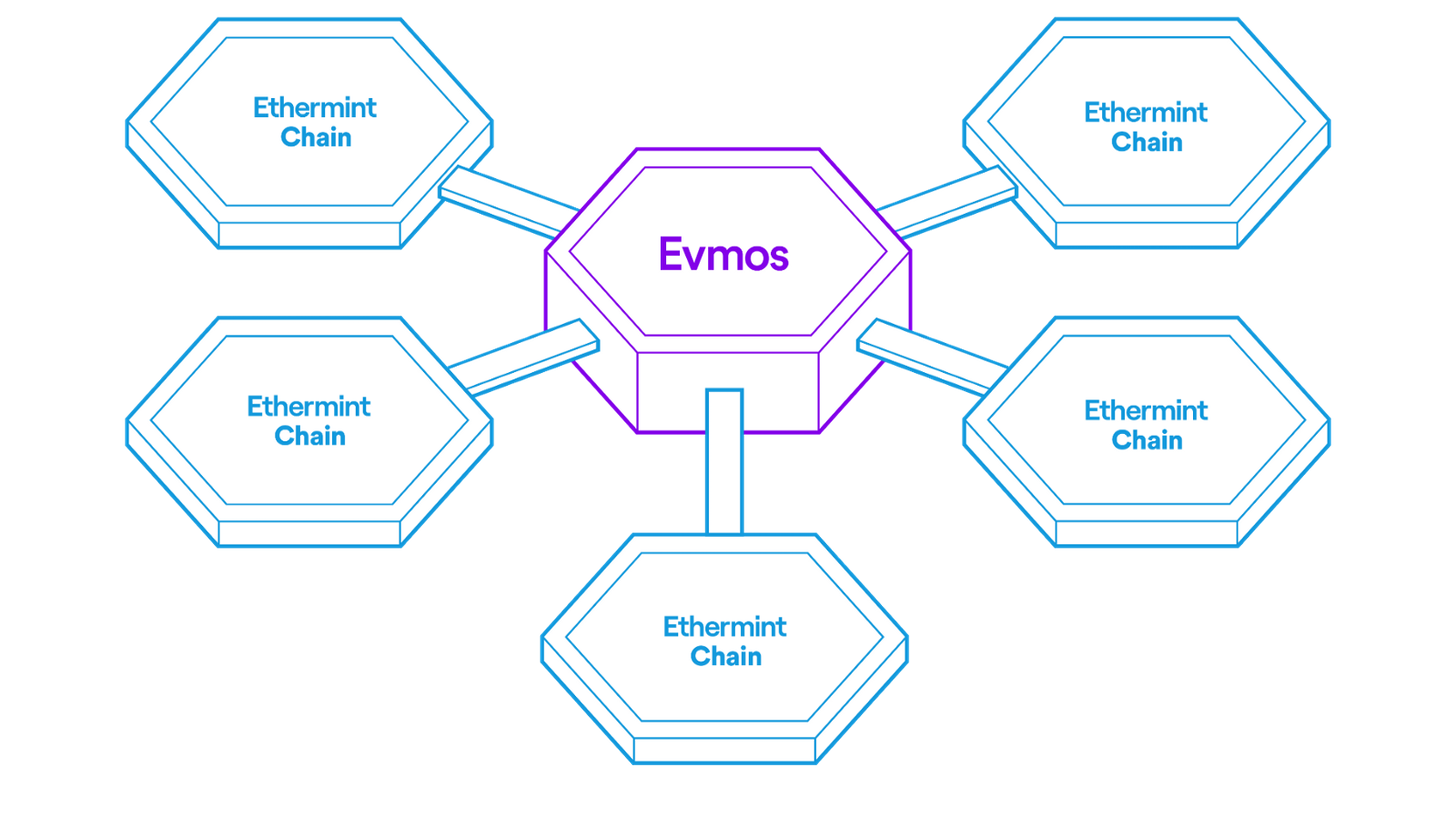

Evmos connects to other Ethermint-based blockchains
Thus, Evmos allows Ethereum to operate as a Cosmos SDK application-specific blockchain. This enables developers to have all the necessary features of Ethereum while benefiting from Tendermint's PoS consensus engine.
This means Evmos can/have:
- EVM compatibility;
- High throughput achieved through the Tendermint consensus engine;
- Horizontal scaling via IBC (improving performance by adding more nodes);
- Fast transaction finality;
Now you might be wondering how all of this is possible? This is achievable because Evmos implements Tendermint, the Cosmos SDK, and leverages the go-Ethereum (geth) library (used to run Ethereum's command-line interface in go (lang)). If that’s not enough to excite you, the next part definitely will.
Evmos also supports a fully compatible JSON-RPC layer, meaning Evmos can interact with existing Ethereum clients and tools like Metamask.
As mentioned earlier, Evmos will also enable users of IBC-supported chains to access the types of protocols seen on Ethereum, including but not limited to decentralized exchanges (DEX), lending protocols, NFT applications, and more.
So why deploy Ethereum-based applications on Evmos?
- Gain Tendermint PoS consensus;
- Faster transactions;
- Lower fees;
- IBC user base;
In summary, EVMOS will be the first EVM blockchain to enable IBC, built with the Cosmos SDK and Tendermint consensus engine. This will allow new and existing EVM applications to integrate with Cosmos.
Here are some examples:
Aave has already proposed and voted to deploy on Evmos, which means there will be a lending market for both Cosmos and Ethereum-based assets on Evmos.
Additionally, Evmos will allow Osmosis to have Ethereum asset pools, so we are likely to see Osmosis implement various financial tools soon.


Connecting the Cosmos IBC ecosystem to the EVM ecosystem
Evmos helps connect over $100 billion in assets and countless EVM-based protocols to Cosmos, opening a new era for decentralized applications and finance in the IBC ecosystem.
Now that we have established the main focus points that Evmos will bring, let’s take a look at some basic technical aspects:
1. Routing
To enable Evmos to handle transactions from EVM and Cosmos modules, it must be able to mimic the transaction structure of Ethereum. It achieves this by simulating the tx structure of geth and treating it as a Cosmos SDK message type. A message contains all relevant Ethereum information, such as signatures, gas, amounts, etc.
2. Pending State
On the Ethereum platform, pending blocks are created when blocks waiting to be mined are queued. These blocks contain pending transactions determined by miners based on the highest gas rewards.
Why is this the case? This is because, on the Ethereum platform, block finality is not possible; instead, it is executed in what we call probabilistic finality, meaning that over time, the likelihood of transactions and resulting blocks being reverted decreases.
On the other hand, Evmos's design is very different because it does not have the concept of "pending/probabilistic state." This is because Evmos uses the Tendermint consensus mechanism, which provides instant (fast) finality for transactions.
For this reason, Evmos does not require a pending state mechanism, as all transactions will be executed in the next block (currently, the average block time on Cosmos is about 8 seconds, but it can be as low as 1 second on Tendermint chains).
3. ERC-20 Module
Now, for Evmos to handle EVM and interact with it, it needs an ERC-20 module.
The basis of this module is that it allows users to convert their ERC-20 tokens on Ethereum to assets on Cosmos and vice versa. Thus, this module implements interoperability between the EVM and Cosmos hubs.
The module also enables developers to write smart contracts that run on Evmos and use EVM assets in other applications within the Cosmos ecosystem.
Additionally, since Evmos is also governed by token holders, it will allow validators and applications to define the fees for any ERC-20 tokens deployed on the Evmos chain.
Then, you might have a question — how does this work?
The module records the association between ERC20 token contract addresses and Cosmos tokens, known as token pairs. These token pairs then allow users to convert their ERC20 tokens into their Cosmos token representations and vice versa.
To create new pairs, Evmos's token holders must create a governance proposal. If the governance proposal passes, the token pair will be added to the module. When this happens, anyone can convert that ERC20 token into its Cosmos counterpart.
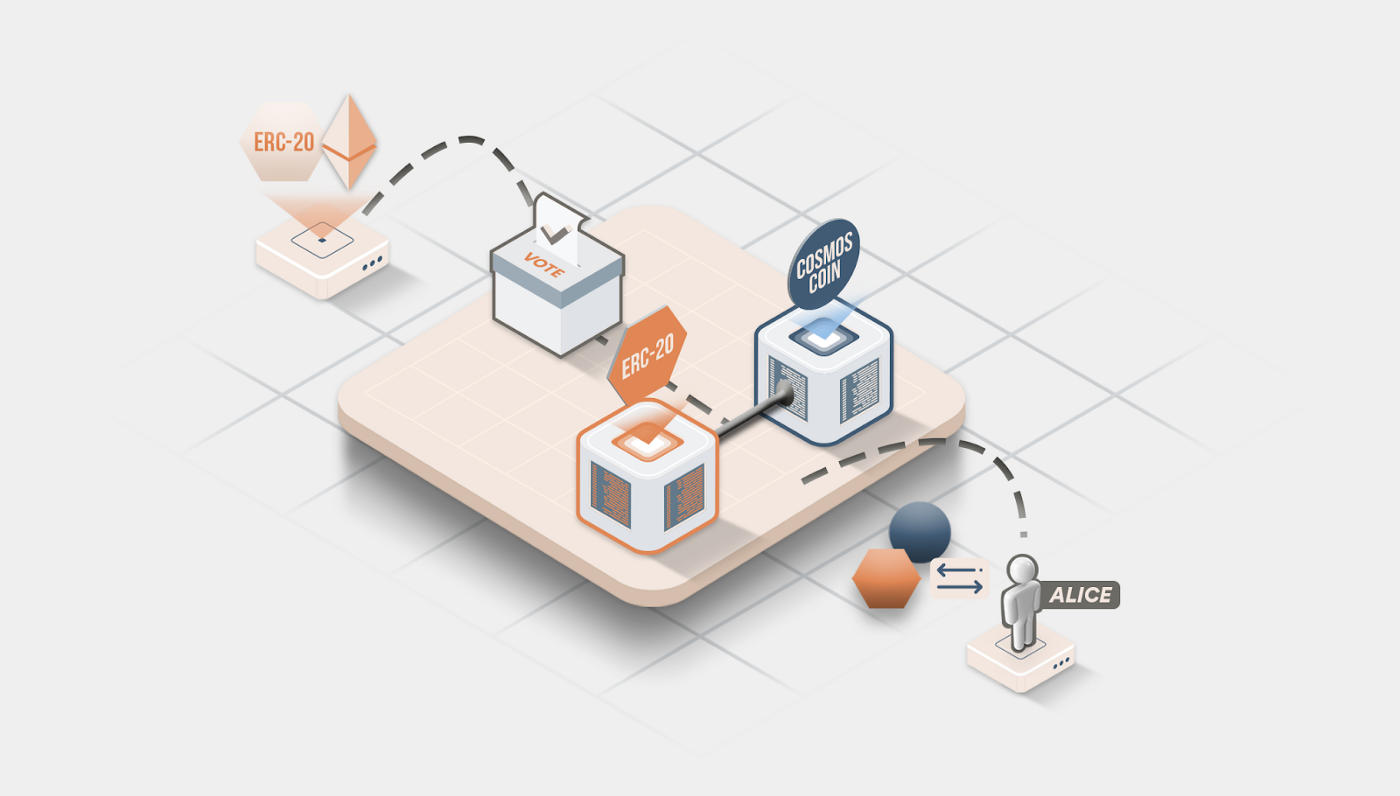

Visual representation of ERC-20->Cosmos module
Thus, this module allows developers to build applications that experiment and innovate multi-chain composability between application-specific blockchains.
Token Economics
Finally, for many, the next part will be the most interesting part of the entire article, which is the Evmos token and its functions.
In the blockchain world, there are typically three groups: developers, users, and block proposers (also known as validators or miners), all of whom play important roles in creating and maintaining value for the network.
However, many blockchains fail to accumulate sustainable value equally for these three important participants. Generally, block proposers (miners) accumulate the majority of the value in the blockchain network, while users and developers (despite being more prevalent and active in the network) receive less value.
So how do we attempt to correct this mistake?
For Evmos, this is how they plan to address this issue:
Evmos will not only serve as a fee and staking token but will also become the first token in the EVM ecosystem to drive chain governance outcomes. Furthermore, it may help determine future economic developments, linking and benefiting the three main actors.
To further this goal, the Evmos token will have five main use cases at launch:
- Reward developers and network operators;
- Vote on protocol upgrades;
- Register tokens on the ERC20 module;
- Determine usage incentives for Evmos-based applications;
- Enable high-priority features;
These usage rewards will further increase as validators and holders will vote to decide on reward measures, creating more value for token holders.


Evmos hopes its design will create a domino effect, as shown in the image above.
Initial Distribution
On the Evmos token launch date of February 28, 40% of the initial supply of 200 million Evmos tokens will be distributed to users through a Rektdrop airdrop, while the remaining 60% will be allocated for community pools and strategic reserves (to serve as accelerators for the Evmos ecosystem).


Inflation Plan
In the first year, the Evmos network will issue an additional 300 million tokens, meaning that the Evmos token will have a high inflation rate initially, which will then decrease exponentially year by year.
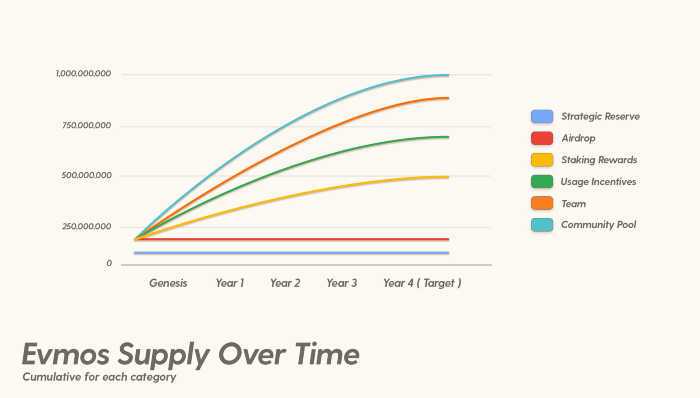

This is similar to the concept of half-life; you might remember the half-life from your physics class (like radioactive decay).
After four years, the distribution of Evmos will come to an end, after which token holders can vote to decide on further distribution methods or token caps.


Like other Tendermint and Cosmos SDK blockchains, if you choose to stake Evmo, the unbonding period for tokens will be three weeks.
Fees/Gas
On the Ethereum platform, much of the token appreciation comes from frustrating gas fees; however, on Tendermint blockchains, gas fees are typically quite low.
But since Evmos is an EVM-compatible chain, it must also be able to fairly match the gas consumption of other EVMs.
Therefore, the gas consumption logic in the Cosmos SDK can be ignored; the gas consumed is calculated by deducting the remaining gas after state transitions (confirming the validity of transactions) plus gas limit refunds.
While on Evmo, we can send transactions with near-zero fees, this is limited to transactions that do not use the EVM module.
Thus, EVM module transactions cannot achieve zero fees because EVM requires gas.
CEVMOS
Another thing that excites me is the partnership between Celestia and Evmos (if you’ve read my Celestia article, you should know this), which will allow the use of Celestia as a data availability layer, providing a modular stack for EVM-based applications.
This will enable efficient rollups based on EVM to operate within the Cosmos hub, with incredible scalability and security.
And this modular chain stack will look like this in practice:


CEVMOS will be specifically optimized for rollups. Therefore, rollups will not have to compete for gas with non-rollup transactions, reducing fees and achieving better scalability. Since it is built with the Cosmos SDK and Optimint, it will connect to the Evmos Hub via IBC and will use Evmos tokens to ensure security and gas.
In practice, this will bring more value to Evmos tokens.
Partnerships
The Evmos team has been working hard to establish partnerships with various protocols to grow the ecosystem, and they have partnered with teams creating AMMs, cross-chain bridges, and more. Let’s take a look at what their partners are trying to achieve on Evmos.
Some of the currently most notable protocols include:
Aave, Diffusion (Uniswap fork), NovaDAO (Ohm fork), Frax (algorithmic stablecoin), Metalancer (Balancer fork), Gamify (NFT marketplace)
Now, more protocols will be built on Evmos, and I believe there will be even more.
You can find updates on new partnerships and projects related to Evmos at evmos.blog.
Additionally, Evmos will also serve as a settlement layer center for multi-chain transactions, which will be made possible through partnerships announced with @nomadxyz and @ConnextNetwork.
Here’s how it works:


Multi-chain transactions enabled by nomad/connext
This will allow ERC-20 tokens to connect across chains to the Cosmos ecosystem.
Airdrop and Mainnet Launch
As mentioned earlier, to distribute tokens at the mainnet launch, Evmos will also adopt the airdrop method used by many Cosmos protocols and will airdrop a significant portion of the initial token supply.
The initial airdrop of 80 million Evmos tokens will be distributed to a vast number of users based on various parameters.
This includes users from the Ethereum ecosystem, Cosmos ecosystem, and various cross-chain bridges.
This is a very unique approach and also helps to decentralize the founding supply to increase fairness.
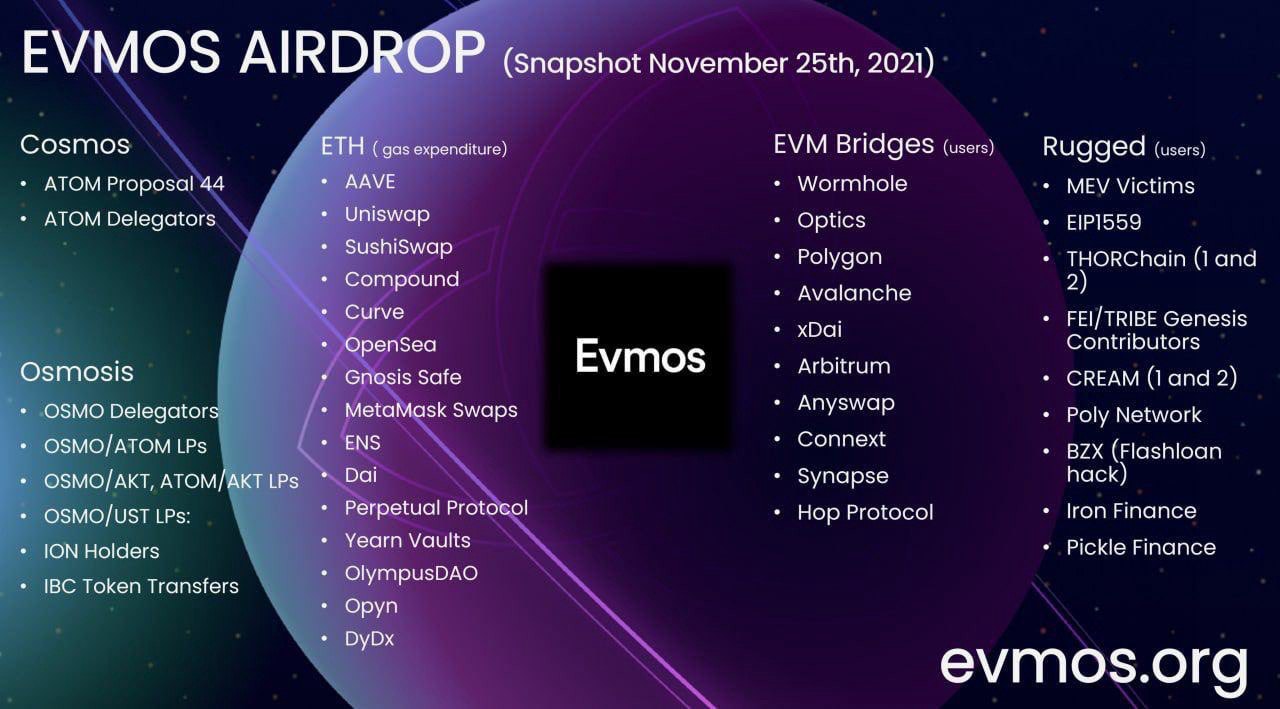

So where can you access Evmos tokens after the mainnet launch on the 28th? At launch, the Evmos network will have several DEXs, here are two of them:
- Exswap
Exswap has confirmed that it will go live immediately when Evmos tokens launch; it is a Uniswap v2 fork project;
- Diffusion
Diffusion is also a Uniswap v2 fork project and will be one of the first AMMs on Evmos.
Currently, there is no available information on whether Evmos will launch on CEX at the mainnet release, but my view is that it is unlikely, as most Evmos tokens will be airdropped to users rather than exchanges.
Therefore, unless the Evmos team uses their strategic reserves to pay exchanges, the best option for participating in Evmos will be DEXs based on Cosmos.
Conclusion
Evmos aims to connect EVM-based applications and assets to an interoperable Cosmos ecosystem while aligning incentives for developers and users, driving innovation in cross-chain composability.










